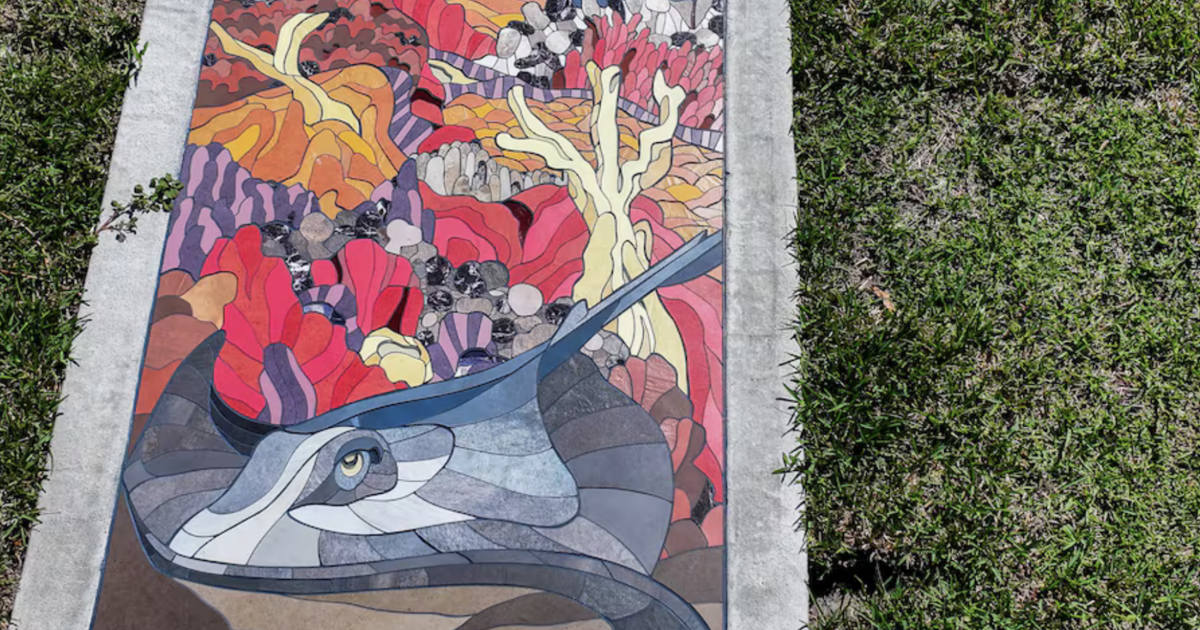St. Petersburg celebrated Oct. 29 the grand opening of a public art project more than three years in the making. It’s billed as the longest mosaic in Florida and one of the longest in the U.S.
The artists behind the “Sunshine City Mosaic” assembled 15,000 pieces of porcelain tile and glass to create nine vignettes of wildlife native to the area, such as an osprey and a green sea turtle.
The mosaic sidewalk starts at its eastern end with animals from Tampa Bay and transitions to wildlife from the Gulf of Mexico as visitors walk west, heading toward the beaches.
The walkable artwork is full of subtle details keen-eyed visitors may notice, like the hexagonal shapes in the background meant to evoke St. Petersburg’s historic sidewalk pavers.
Near the center lies the image of a green anole. Early on, the artists debated whether to do a brown anole. The brown lizards have become more common in Florida — and would have required far less expensive and easier-to-find brown tile — but are invasive.
Green won out.
The city commissioned the publicly funded work in April 2023 after putting out a call for artists in 2022.
Alex Kaufman, who crafted the piece alongside George Retkes and Laura Spencer, known as Miss Crit, said the intent was to bring attention to one of the city’s lesser-known public parks.
The sidewalk cuts through Sunset Park, a small green space along the Intracoastal Waterway at the western edge of Central Avenue, just before it becomes the Treasure Island Causeway.
It’s also practical, allowing strollers to avoid the busy corner at Central Avenue and Park Street South.
The $50,000 work debuts at a time of greater scrutiny on government spending, with public art and arts programs among the most criticized budget items by conservatives looking to curb what they describe as waste.
In Pinellas County, commissioners voted this summer to defund Creative Pinellas, an organization that provided funding and opportunities for artists and public art projects.
Kaufman points out that all three of the artists behind the “Sunshine City Mosaic” had previously received grants from Creative Pinellas in the form of emerging artist awards that helped launch their careers.
The mosaic, he said, shows how that early support makes artists competitive in a competitive art market and eventually leads to notable work in the region.
“It is not a direct tie because that is not how art is built,” Kaufman said. “But it is all about foundations and opportunities.”
The mosaic also debuts months after the controversial removal of other public art on prominent local walkways. The state removed murals painted in streets and intersections around St. Petersburg, Tampa and beyond, citing new state rules and a desire to keep roads clear of social messaging.
While there is nothing foreseeably controversial about the content of the Sunshine Mosaic, Kaufman said the funding of public art in general is a quality-of-life question.
“There’s a reason people gravitate toward older things, and that’s because in the past 30, 40 years of development, there’s a lot of soul sucked out of our general space,” he said. “Public art is a way to beautify our spaces, and one that, for the amount of money cities spend on it, brings a greater impact than anything else.”
Kaufman said that while $50,000 might sound like a lot, the artists worked “basically, for cost.” They agreed to that, he said, because they were bidding for the job against more established artists.
Now the hope is that the quality of the work helps them land more and bigger jobs so they can continue creating.
Part of the cost of the job was running and repairing a rare, 12-foot-long, 87,000 PSI waterjet machine to cut the tile. The machine is powerful enough to cut through metal with water at the force of 45 pressure washers combined.
Other delays included hurricane flooding that beached unmoored boats in the middle of the park.
Miss Crit created the wildlife images initially as sketches, while Retkes, known primarily as a sculptor, did the cutting and surfacing.
The sidewalk features dozens of different colors and textures of tile, sourced from around the world.
Kaufman, lead designer for MGA Sculpture Studio, which created the metal sculpture outside St. Petersburg Police Department headquarters, solved the design puzzle of transforming it all into a mosaic.
The trio spent months on their hands and knees over the summer assembling all 15,000 pieces by hand, fighting humidity and mosquitoes as they sometimes worked past midnight under tents and lights.
The project has been their baby for years, but now it belongs to everyone.

